Origin of D-amino acids
“We eat optically active bread & meat, live in houses, wear clothes, and read books made of optically active cellulose. The proteins that make up our muscles, the glycogen in our liver and blood, the enzymes and hormones, the sugars in DNA and RNA and in the metabolic pathways … are all optically active. Naturally occurring substances are optically active because the enzymes which bring about their formation … are optically active. As to the origin of the optically active enzymes, we can only speculate” (from Morrison and Boyd, 1987).
Handedness is a complete mystery to evolutionists
(is homochirality in the monomeric building blocks of biopolymers a condition for initiating prebiotic chemistry?)
The alternative to an evolutionary origin of homochirality is that it was achieved prior to the origin of life. In the primordial soup, D- and L-AAs would likely have been present in nearly equal amounts. The preference for L-AAs has been explained differently: a) certain chemical processes were favored energetically, leading to increased levels of L-isomers of amino acids on the early Earth; b) meteorites brought L-AAs to Earth, thus providing an imbalance that may have favored the formation of life; or c) it is related to the creationistic theory of origin of life.
The mystery has not been solved yet!
According to the LOH theory (hydrate hypothesis of the origin of living matter), amino acids originated within the methane-hydrate localizations from natural gas and niter and included sulfur-containing substances at temperatures close to those of living organisms. The geometric differences of the L- and D-forms are rather significant: accordingly, the mechanisms of the sets of elementary steps that led to their formation from the source methane and nitrate are quite different.
At 270-290 K, the reaction proceeded slowly: the direction of the synthesis and the final optical structure of any amino acid was dictated not by thermodynamics, but rather by kinetics! Racemization is expected but proceeds extremely slowly (see below).
The primary amino acids (and proteins) were produced from natural gas and niter at a low temperature and within solid/semiliquid gas-hydrate structures: under these conditions, only L-AAs were produced that could not transform into the D-form because of the kinetic nature. Each amino acid was formed within some cavity and was not in contact with other amino acid molecules: L-AA is produced that cannot be transformed into the D-enantiomer.
The reaction by which L- and D-isomers of amino acids are formed proceeds at different rates under the same ambient conditions. Racemization is thermodynamically expected, but kinetically inhibited as a result of differences in the rates of formation of different optical isomers because of the complexity of the intramolecular rearrangements (racemization of asparagine acid ester has a rate of 0.1% per year). It seems very probable that certain D-AAs present on the primitive Earth had an excess of enantiomers and that these excesses were large enough to be susceptible to amplification (e.g., by polymerization).
Monod (1970) stated: “homochirality of terrestrial life was a necessity and not a matter of chance selection”.
Origin of homochirality
- Spontaneous breakage of symmetry:
- a) Spontaneous separation of a racemic mixture into its constituent enantiomers during crystallization (probably quite difficult on the primitive Earth)
- b) Selective adsorption of one enantiomer from a racemic mixture at the surface of a chiral crystal (i.e., quartz crystals)
- Homochirality arose from statistical fluctuation from the equimolar condition. The energy difference between enantiomers is called the parity-violating energy difference (PVED, 10-14 J/mol, corresponding to an enantiomeric excess of 10-15%). The violation of parity constitutes a symmetry breakage at the level of the basic laws of atomic physics.
Experimental evidence:
– Compounds can strongly influence the excess of enantiomers in solution under solid-liquid equilibrium conditions (e.g., the enantiomeric excess of valine increases from 47% to 99% in the presence of fumaric acid);
– Polymerization of a Glu derivative occurs at a 20-fold faster rate starting with molecules of the same chirality (L-L or D-D reactions) than with a racemic mixture (L-D or D-L reactions). Biopolymers result from the polymerization of chiral monomers.
Note for protein biochemists: natural proteins are made by L-AAs. An HIV-1 protease was synthesized using D-AAs (Borman, 1992): it exhibits catalytic activity identical to that of the native enzyme except that it is specific for the opposite enantiomer of the substrate.
References
Borman S. (1992) Mirror-image structures; enzyme made using all D-amino acids. Chem. Eng. News, 70 (23): 4–5
Dolgin E. (2009). “Did lefty molecules seed life?” – The Scientist Magazine
Doolittle R. (1983) Probability and the origin of life. In: Godfrey, L.R., ed., Scientists Confront Creationism, W.W. Norton, NY.
Kadyshevich E.A. and Ostrovskii V.E. (2016) Natural mechanism of origination and conservation of monochirality of amino acids. Chirality 28(2):153-157
Klussmann M., Toshiko I., White A.J.P., Armstrong A., Blackmond D.G., Emergence of solution-phase homochirality via crystal engineering of amino acids (2007), J. Am. Chem. Soc. 129: 7657-7660
Morrison R.T. and Boyd R.N. (1987). Organic Chemistry, 5th ed. (Allyn & Bacon Inc.), page 150
Riddle M. (2008). Can natural processes explain the origin of life? – The New Answers Book 2, ed. Ken Ham (Green Forest, AR: Master Books), pp. 15-24
Author
Loredano Pollegioni, Università degli studi dell’Insubria
